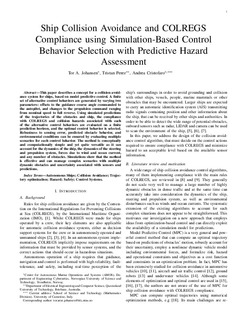| dc.contributor.author | Johansen, Tor Arne | |
| dc.contributor.author | Perez, Tristan | |
| dc.contributor.author | Cristofaro, Andrea | |
| dc.date.accessioned | 2017-12-11T08:54:36Z | |
| dc.date.available | 2017-12-11T08:54:36Z | |
| dc.date.created | 2016-12-17T12:27:11Z | |
| dc.date.issued | 2016 | |
| dc.identifier.citation | IEEE transactions on intelligent transportation systems (Print). 2016, 17 (12), 3407-3422. | nb_NO |
| dc.identifier.issn | 1524-9050 | |
| dc.identifier.uri | http://hdl.handle.net/11250/2469879 | |
| dc.description.abstract | This paper describes a concept for a collision avoidance system for ships, which is based on model predictive control. A finite set of alternative control behaviors are generated by varying two parameters: offsets to the guidance course angle commanded to the autopilot and changes to the propulsion command ranging from nominal speed to full reverse. Using simulated predictions of the trajectories of the obstacles and ship, compliance with the Convention on the International Regulations for Preventing Collisions at Sea and collision hazards associated with each of the alternative control behaviors are evaluated on a finite prediction horizon, and the optimal control behavior is selected. Robustness to sensing error, predicted obstacle behavior, and environmental conditions can be ensured by evaluating multiple scenarios for each control behavior. The method is conceptually and computationally simple and yet quite versatile as it can account for the dynamics of the ship, the dynamics of the steering and propulsion system, forces due to wind and ocean current, and any number of obstacles. Simulations show that the method is effective and can manage complex scenarios with multiple dynamic obstacles and uncertainty associated with sensors and predictions. | nb_NO |
| dc.language.iso | eng | nb_NO |
| dc.publisher | IEEE | nb_NO |
| dc.title | Ship collision avoidance and COLREGS compliance using simulation-based control behavior selection with predictive hazard assessment | nb_NO |
| dc.type | Journal article | nb_NO |
| dc.type | Peer reviewed | nb_NO |
| dc.description.version | acceptedVersion | nb_NO |
| dc.source.pagenumber | 3407-3422 | nb_NO |
| dc.source.volume | 17 | nb_NO |
| dc.source.journal | IEEE transactions on intelligent transportation systems (Print) | nb_NO |
| dc.source.issue | 12 | nb_NO |
| dc.identifier.doi | 10.1109/TITS.2016.2551780 | |
| dc.identifier.cristin | 1414390 | |
| dc.relation.project | Norges forskningsråd: 244116 | nb_NO |
| dc.relation.project | Norges forskningsråd: 223254 | nb_NO |
| dc.description.localcode | This is the authors' accepted and refereed manuscript to the article. © 2016 IEEE. Personal use of this material is permitted. Permission from IEEE must be obtained for all other uses, in any current or future media, including reprinting/republishing this material for advertising or promotional purposes, creating new collective works, for resale or redistribution to servers or lists, or reuse of any copyrighted component of this work in other works. | nb_NO |
| cristin.unitcode | 194,63,25,0 | |
| cristin.unitname | Institutt for teknisk kybernetikk | |
| cristin.ispublished | true | |
| cristin.fulltext | postprint | |
| cristin.qualitycode | 1 | |
